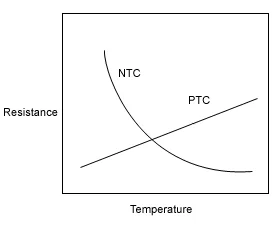Peak Sensors Thermistor Information
TL;DR — Quick Summary
Thermistors are thermally sensitive resistors that change resistance with temperature. There are two main types:
- NTC (Negative Temperature Coefficient): Resistance decreases as temperature rises; highly sensitive, ideal for precise measurements.
- PTC (Positive Temperature Coefficient): Resistance increases with temperature; resistance change is more linear but smaller.
Thermistors are small, inexpensive, and suitable for a wide range of temperatures, typically -55°C to 150°C, with some stable up to 300°C. Standard devices require only two connection wires and low power to prevent self-heating.
What Are Thermistors?
Thermistors are resistors that respond to temperature changes. Their resistance varies with temperature, making them useful for temperature sensing, control, and protection applications.
NTC Thermistors (Negative Temperature Coefficient)
- Resistance decreases as temperature increases.
- Exhibit large resistance changes (4–5% per °C).
- Highly stable and repeatable.
- Small and cost-effective, particularly in high volumes.
- Standard resistances at 25°C include 2,252 Ω, 5,000 Ω, and 10,000 Ω.
- Excellent for precision measurement, though the resistance vs. temperature curve is nonlinear.
PTC Thermistors (Positive Temperature Coefficient)
- Resistance increases as temperature rises.
- Linear change in resistance with temperature, but the magnitude of change is smaller than NTC devices.
- Easier to use in circuits needing predictable resistance changes, but less sensitive for precise measurement.

Thermistor Construction
Thermistor elements are joined to connection leads, which are insulated and protected. There is a wide variety of designs, allowing thermistors to be tailored for specific industrial or laboratory applications.

PTC vs NTC — Key Differences
- A low-power source is applied to read resistance; power must be minimal to avoid self-heating, which could skew readings.
- Thermistors are designed for standard temperature ranges of -55°C to 150°C, though some high-grade devices remain stable up to 300°C.
- Only two connection wires are needed, as the device operates at very high resistance compared to the leads.
| Feature | NTC Thermistor | PTC Thermistor |
|---|---|---|
| Resistance vs Temperature | Decreases as temperature rises | Increases as temperature rises |
| Sensitivity | High | Moderate |
| Linearity | Nonlinear | Mostly linear |
| Applications | Precision measurement | Overcurrent protection, simple temp monitoring |
| Cost | Low | Low to moderate |
Advantages of Thermistors
- Small size for compact applications
- Cost-effective and reliable
- High sensitivity (NTC) for accurate temperature measurement
- Wide operating temperature range
- Easy connection to instruments (only 2 wires needed)
FAQs
Q: Which thermistor type is better for precision temperature measurement?
NTC thermistors are more sensitive and suitable for high-precision applications.
Q: Can thermistors operate at very high temperatures?
Standard thermistors operate -55°C to 150°C, but some high-grade devices remain stable up to 300°C.
Q: How many wires are needed to connect a thermistor?
Only two wires are needed because the thermistor’s resistance is high relative to the leads.
Q: Do thermistors require special circuitry?
No special leads are needed, but the power source should be low to prevent self-heating, which could affect readings.
Thermistor Enquiries
We manufacture bespoke thermistor assemblies. If you are unsure what assembly you require, call us and we can solve your temperature problem.
Submit an Enquiry
"*" indicates required fields
